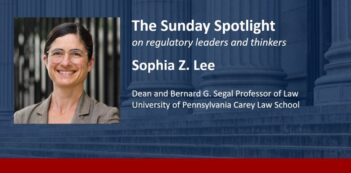
Law schools need to create a comprehensive curricular path for students who are pursuing regulatory careers.
When I was in law school in the late 1990s, my classmates and I received the message that legal employment generally fell into one of two categories: litigation or transactional. Whether that message was accurate then is undoubtedly debatable. Today, that message is flat wrong. Many contemporary lawyers never see the inside of a courtroom and have little involvement with corporate transactions. Law schools need to recognize a third employment track that at least matches, if not dwarfs, the other two: regulatory practice.
So many areas of legal practice fit this description: banking, employee benefits, employment discrimination, energy and environment, food and drug, health care, immigration, securities, tax, telecommunications, transportation—the list goes on and on. In these areas, private sector lawyers spend their time advising clients about the nature and scope of their obligations under one or several regulatory regimes, helping clients conform their behavior to those requirements, and representing their clients before federal and state regulators, whether by drafting comments in response to notices of proposed rulemakings or in agency-level enforcement proceedings. On the government side, regulatory lawyers focus on writing legislation, developing regulations, drafting informal guidance documents, and pursuing enforcement actions.
Many law schools offer one or more specialty courses on the substance of particular regulatory topics, but historically they have not done a great job of preparing their students more generally for employment in regulatory practice. The recent trend of adding a Legislation and Regulation or Regulatory State course as a required part of the first-year curriculum is a step in the right direction. But law schools should consider these introductory course requirements as only a first step toward developing a true regulatory practice track for interested students.
In the first-year curriculum, even the Regulatory State and Legislation and Regulation courses are not identical or even necessarily mutually exclusive. The Legislation and Regulation textbook by John Manning and Matthew Stephenson presents a very different vision of the first-year course compared to The Regulatory State textbook by Lisa Bressman, Edward Rubin, and Kevin Stack, for example. Looking beyond the first-year curriculum, therefore, separate courses in Administrative Law, Legislation, and Statutory Interpretation for upper-level students may need to be rethought and presented differently, depending upon which model of first-year course a law school chooses to follow.
Following a different track, Geoffrey Miller has written a path-breaking textbook, The Law of Governance, Risk Management and Compliance, that addresses particular issues of growing importance for regulated firms and the attorneys who advise them. Similarly, Daniel Sokol has written about the need for and challenges of helping law students develop the analytical skills that are necessary to succeed in regulatory compliance careers.
Other specialized courses and classroom opportunities abound. One prime example isThe Regulatory Review itself, an online regulatory publication that is produced through a seminar taught by Cary Coglianese at the University of Pennsylvania. Another is a Regulatory Law and Policy course developed by Sidney Shapiro and Joseph Tomain, which considers how law attempts to address different types of market and regulatory failures across various areas of government regulation. Clinical and other experiential opportunities exist as well.
In short, law schools seeking to prepare students for today’s job market need to think beyond whether to add just a single Legislation and Regulation or Regulatory State course to the first-year curriculum. Just as law schools have developed areas of study for students who are interested in becoming litigators or transactional attorneys, they should also dedicate themselves to creating a comprehensive curricular path for students who want to pursue careers in regulatory practice.
This essay is part of The Regulatory Review’s five-part series, Innovations in Teaching Regulatory Law.




